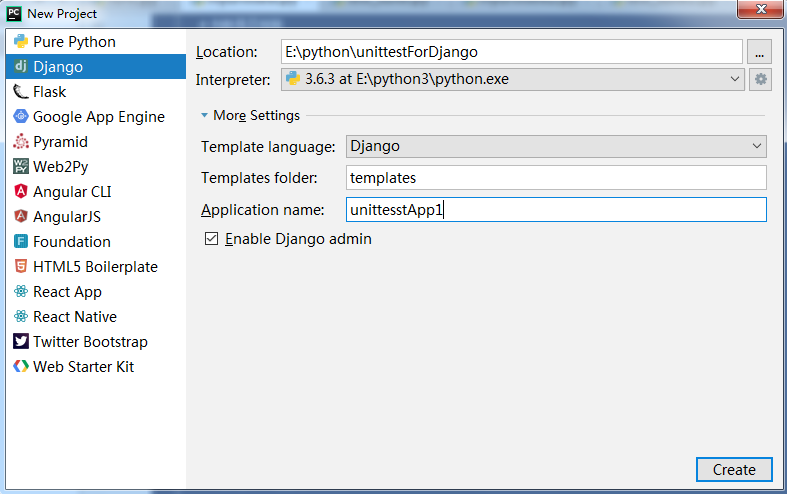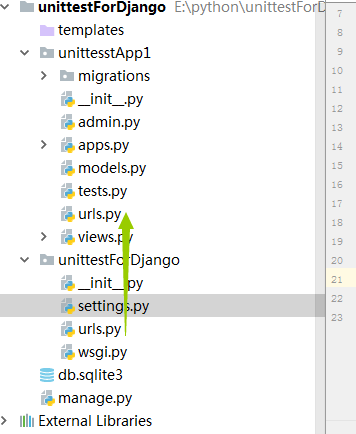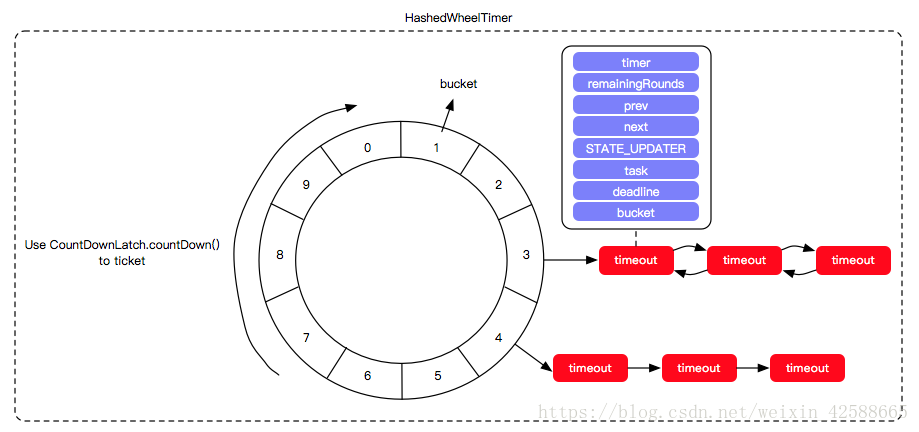python自動化測試三部曲之request+django實現介面測試
- 2019 年 10 月 19 日
- 筆記
國慶期間準備寫三篇部落格,介紹和總結下介面測試,由於國慶期間帶娃,沒有按照計劃完成,今天才完成第二篇,慚愧慚愧。
這裡我第一篇部落格的地址:https://www.cnblogs.com/bainianminguo/p/11616526.html,主要是介紹unittest框架,有興趣的同學們可以移步去查閱
這裡廢話少說,進入正題
我的思路是這樣的
1、先用django實現登陸、增加、刪除、查看4個介面
2、在excel定義好測試案例、然後讀取excel中的案例,然後把案例用unittest框架組裝和封裝
3、啟動django,執行測試案例
一、先跑通unittest到django的流程
1、先創建一個Django的項目

2、創建路由,這裡我們使用二級路由
a、先複製工程目錄下的urls.py文件到app目錄下

b、修改工程目錄下的urls.py文件,定義一級路由

c、修改app目錄下的urls.py文件,設置二級路由,這裡切記務必要刪除默認的admin這條路由

d、定義這條路由指向的視圖的函數

e、啟動django,這裡我們使用9090埠啟動,因為我們的Jenkins埠用的是8080
E:pythonunittestForDjango>python manage.py runserver 9090
f、這裡的是啟動成功的樣式,我圈住的告警可以忽略,因為這裡Django的admin需要的,我們這裡不會用到django的admin

g、打開瀏覽器訪問django,我們的一個簡單的Django項目已經跑通

3、在視圖函數中定義一個方法,這個方法分別處理GET請求和POST請求
a、定義視圖函數
這裡通過這個參數告訴瀏覽器,我們返回的是JSON數據
return HttpResponse(result, content_type="application/json;charset=utf-8")
def test_login(request): method = request.method.upper() if method == "GET": result = {} name = request.GET.get("username",None) pwd = request.GET.get("pwd",None) result["name"] = name result["pwd"] = pwd result = json.dumps(result) # return HttpResponse(result) return HttpResponse(result, content_type="application/json;charset=utf-8") else: result = {} name = request.POST.get("username",None) pwd = request.POST.get("pwd",None) result["name"] = name result["pwd"] = pwd result = json.dumps(result) return HttpResponse(result,content_type="application/json;charset=utf-8")
b、使用request模組發起POST和GET請求
#Auther Bob #--*--conding:utf-8 --*-- import requests import json class TestCase(object): def __init__(self,username,pwd,url): self.username = username self.pwd = pwd self.url = url def get(self): # 發送get請求 url = self.url + "?username=" + str(self.username) + "&" + "pwd=" + str(self.pwd) res = requests.get(url=url) print(res.text,type(res.text)) def post(self): # 發送post請求 data = { "username" : self.username, "pwd" : self.pwd } res = requests.post(url=self.url,data=data) print(res.text) if __name__ == '__main__': url = "http://127.0.0.1:9090/web/login/" username = "zhangsan" pwd = "123" t = TestCase(username,pwd,url) t.get() t.post()
c、這裡我們引入unittest框架,測試案例可以這麼寫
import unittest from test3 import test_request class TestDjango(unittest.TestCase): def setUp(self): print("unittest框架的前置條件") def tearDown(self): print("unittest框架的後置條件") def test_01(self): url = "http://127.0.0.1:9090/web/login/" username = "zhangsan" pwd = "123" t = test_request.TestCase(url=url,username=username,pwd=pwd) def test_02(self): url = "http://127.0.0.1:9090/web/login/" username = "zhangsan" pwd = "123" t = test_request.TestCase(url=url,username=username,pwd=pwd) t.post() if __name__ == '__main__': unittest.main(verbosity=2)
d、這裡有重複程式碼,我們可以利用unittest框架中的classmethod來解決,因為實例化一個測試類可以放在前置條件中
import unittest from test3 import test_request class TestDjango(unittest.TestCase): @classmethod def setUpClass(cls): url = "http://127.0.0.1:9090/web/login/" username = "zhangsan" pwd = "123" # 這裡的t雖然是類變數,但是python的中的實例是可以用引用類變數的 cls.t = test_request.TestCase(url=url,username=username,pwd=pwd) def setUp(self): print("unittest框架的前置條件") def tearDown(self): print("unittest框架的後置條件") def test_01(self): self.t.get() def test_02(self): self.t.post() if __name__ == '__main__': unittest.main(verbosity=2)
e、在testcase中加入斷言
import unittest from test3 import test_request class TestDjango(unittest.TestCase): @classmethod def setUpClass(cls): url = "http://127.0.0.1:9090/web/login/" username = "zhangsan" pwd = "123" # 這裡的t雖然是類變數,但是python的中的實例是可以用引用類變數的 cls.t = test_request.TestCase(url=url,username=username,pwd=pwd) def setUp(self): print("unittest框架的前置條件") def tearDown(self): print("unittest框架的後置條件") def test_01(self): res = self.t.get() self.assertEqual(200,res.status_code) def test_02(self): res = self.t.post() self.assertEqual(200, res.status_code) if __name__ == '__main__': unittest.main(verbosity=2)
f、引入testsuite
import unittest from unittest import TestLoader from test3 import test_unittest if __name__ == '__main__': suite = unittest.TestSuite() loader = TestLoader() test_cases1 = unittest.TestLoader().loadTestsFromModule(test_unittest) # 參數是一個模組,會把這個模組里的所有case載入進來 suite.addTests(test_cases1) runner = unittest.TextTestRunner(verbosity=2) runner.run(suite)
二、在django中設計介面
這裡我們寫一個簡單的例子,設計一個用戶表,設計4個介面
介面1:登陸
介面2:增加用戶,需要用戶登陸
介面3:刪除用戶,需要用戶登陸
介面4:查詢用戶,不需要用戶登陸
1、先看登陸介面
a、登錄介面對應的url
下面是一級路由
url(r'^web/', include('unittesstApp1.urls'))
下面是二級路由
url(r'^login/', views.test_login),
b、登錄介面的視圖函數
def test_login(request): method = request.method.upper() if method == "GET": returndict = {"code": 200, "error": None} username = request.GET.get("username",None) password = request.GET.get("password",None) if username == "admin" and password == "admin123.": request.session["username"] = username request.session["password"] = password result = json.dumps(returndict) else: returndict["code"] = 201 returndict["error"] = "用戶名或者密碼錯誤" result = json.dumps(returndict) return HttpResponse(result,content_type="application/json;charset=utf-8")
這裡我們用到了session來代替cookies
2、增加用戶介面
a、增加用戶對應的url
一級路由同登陸介面,下面是二級路由
url(r'^add/', views.test_add),
b、增加用戶介面對應的視圖函數,這裡我們做了各種異常處理,且判斷了用戶是否登陸,也就是通過是否攜帶cookies來判斷
def test_add(request): method = request.method.upper() if method == "POST": returndict = {"code": 200, "error": None} username = request.session.get("username",None) password = request.session.get("password",None) if username == "admin" and password == "admin123.": newusername = request.POST.get("username",None) age = request.POST.get("age",None) sex = request.POST.get("sex",None) pwd = request.POST.get("pwd",None) userinfo = [newusername,age,sex,pwd] print(userinfo) if not "None" in userinfo and all(userinfo): if models.userInfo.objects.filter(username = userinfo[0]).exists(): returndict["error"] = "{username} is exists,please add a new username".format(username = username) returndict["code"] = 201 result = json.dumps(returndict) return HttpResponse(result, content_type="application/json;charset=utf-8") else: models.userInfo.objects.create( username = newusername, age = age, sex = sex, pwd = pwd ) if models.userInfo.objects.filter(username=userinfo[0]).exists(): result = json.dumps(returndict) return HttpResponse(result, content_type="application/json;charset=utf-8") else: returndict["error"] = "{username} is error,please retry add".format(username=username) returndict["code"] = 201 result = json.dumps(returndict) return HttpResponse(result, content_type="application/json;charset=utf-8") else: returndict["error"] = "must input username,age,sex,pwd" returndict["code"] = 201 result = json.dumps(returndict) return HttpResponse(result, content_type="application/json;charset=utf-8") else: returndict = {"code": 201, "error": "用戶名或者密碼錯誤"} result = json.dumps(returndict) return HttpResponse(result, content_type="application/json;charset=utf-8")
3、刪除介面
a、刪除用戶對應的url
一級路由同登陸介面,這裡只看二級路由
url(r'^del/', views.del_user),
b、刪除介面對應的視圖函數,這裡我做了各種異常處理,也做了用戶是否登陸的檢測,也是通過檢測cookies來實現
def del_user(request): method = request.method.upper() if method == "POST": returndict = {"code": 200, "error": None} username = request.session.get("username",None) password = request.session.get("password",None) if username == "admin" and password == "admin123.": delusername = request.POST.get("username",None) print(delusername) if delusername != None: if models.userInfo.objects.filter(username=delusername).exists(): delid = models.userInfo.objects.get(username=delusername).id print(delid) try: models.userInfo.objects.get(id=delid).delete() except Exception as e: returndict = {"code": 201, "error": e} result = json.dumps(returndict) return HttpResponse(result, content_type="application/json;charset=utf-8") else: result = json.dumps(returndict) return HttpResponse(result, content_type="application/json;charset=utf-8") else: returndict = {"code": 201, "error": "{username} is not exists".format(username = delusername)} result = json.dumps(returndict) return HttpResponse(result, content_type="application/json;charset=utf-8") else: returndict = {"code": 201, "error": "you must input a username"} result = json.dumps(returndict) return HttpResponse(result, content_type="application/json;charset=utf-8") else: returndict = {"code": 201, "error": "username or password is error"} result = json.dumps(returndict) return HttpResponse(result, content_type="application/json;charset=utf-8")
4、查看介面
a、查看介面對應的url
一級路由同登陸介面url,下面是二級路由
url(r'^scan/', views.get_user),
b、查看介面對應的url,這裡我們不檢測用戶是否登陸,直接把查到的數據返回給客戶,如果查詢報錯,才返回錯誤的資訊
def get_user(request): method = request.method.upper() returndict = {"code": 200, "userinfo": None} if method == "GET": try: alluser = models.userInfo.objects.all().values_list("username") alluserlist = [] for i in alluser: alluserlist.append(i) returndict["userinfo"] = alluserlist except Exception as e: returndict["code"] = "201" returndict["error"] = e finally: result = json.dumps(returndict) return HttpResponse(result, content_type="application/json;charset=utf-8")
5、設計刪除資料庫中所有的介面,用來做後置條件
def del_alluser(request): method = request.method.upper() if method == "POST": returndict = {"code": 200, "error": None} username = request.session.get("username", None) password = request.session.get("password", None) if username == "admin" and password == "admin123.": if models.userInfo.objects.all().count() > 0: models.userInfo.objects.all().delete() result = json.dumps(returndict) return HttpResponse(result, content_type="application/json;charset=utf-8")
三、案例準備
1、在excel中寫好介面測試案例

2、定義常量,也就是每列對應的值
class TestConfig(object): def __init__(self): self.name = 0 self.url = 1 self.method = 2 self.cookies = 3 self.data = 4 self.res = 5 self.exec = 6 def getname(self): return self.name def geturl(self): return self.url def getmethod(self): return self.method def getcookies(self): return self.cookies def getdata(self): return self.data def getres(self): return self.res def getexec(self): return self.exec
3、定義讀取excel的類,因為我要從excel中讀取案例
import xlrd import os class testexcel(object): casepath = os.path.join(os.path.dirname(os.path.dirname(os.path.abspath(__file__))), "case", "testcase.xlsx") def __init__(self): self.casepath = testexcel.casepath self.execlobj = xlrd.open_workbook(self.casepath) self.sheetobj = self.execlobj.sheet_by_index(0) def get_excel_data(self,row,col): max_row = self.get_excel_max_row() max_col = self.get_excel_max_col() if row > max_row -1 or col > max_col - 1: return False else: data = self.sheetobj.cell_value(row,col) return data def get_excel_max_row(self): r_num = self.sheetobj.nrows return r_num def get_excel_max_col(self): c_num = self.sheetobj.ncols return c_num
4、定義我們的介面函數
import requests import json class TestLogin(object): def __init__(self,username,pwd,url): self.username = username self.pwd = pwd self.url = url def get(self): # 發送get請求 url = self.url + "?username=" + str(self.username) + "&" + "password=" + str(self.pwd) res = requests.get(url=url, headers={ "user-agent": "Mozilla/5.0 (Windows NT 6.1) AppleWebKit/537.36 (KHTML, like Gecko) Chrome/57.0.2987.133 Safari/537.36" }) # print(json.loads(res.text)) return res def post(self): # 發送post請求 data = { "username" : self.username, "pwd" : self.pwd } res = requests.post(url=self.url, data=data, headers={ "user-agent": "Mozilla/5.0 (Windows NT 6.1) AppleWebKit/537.36 (KHTML, like Gecko) Chrome/57.0.2987.133 Safari/537.36" }, ) # print(res.text) return res class TestAdd(object): def __init__(self,username,age,sex,pwd,cookies,url): self.username = username self.age = age self.sex = sex self.pwd = pwd self.url = url self.cookies = cookies def post(self): # 發送post請求 data = { "username" : self.username, "pwd" : self.pwd, "age" : self.age, "sex" : self.sex } res = requests.post(url=self.url, data=data, headers={ "user-agent": "Mozilla/5.0 (Windows NT 6.1) AppleWebKit/537.36 (KHTML, like Gecko) Chrome/57.0.2987.133 Safari/537.36" }, cookies=self.cookies, ) # print(res.text) return res class Testdel(object): def __init__(self, username,cookies,url): self.username = username self.cookies = cookies self.url = url def post(self): # 發送post請求 data = { "username": self.username, } res = requests.post(url=self.url, data=data, headers={ "user-agent": "Mozilla/5.0 (Windows NT 6.1) AppleWebKit/537.36 (KHTML, like Gecko) Chrome/57.0.2987.133 Safari/537.36" }, cookies=self.cookies, ) # print(res.text) return res class Testscan(object): def __init__(self,url): self.url = url def get(self): res = requests.get(url=self.url, headers={ "user-agent": "Mozilla/5.0 (Windows NT 6.1) AppleWebKit/537.36 (KHTML, like Gecko) Chrome/57.0.2987.133 Safari/537.36" }, cookies=None, ) return res
5、定義測試案例
import unittest from test3 import test_request import json from util import test_json from util import test_excel from case import testconfig import requests class TestDjango(unittest.TestCase): @classmethod def setUpClass(cls): cls.alldata = test_json.testjson() @classmethod def tearDownClass(cls): url = "http://127.0.0.1:9090/web/login/" + "?username=" + "admin" + "&" + "password=" + "admin123." res = requests.get(url=url, headers={ "user-agent": "Mozilla/5.0 (Windows NT 6.1) AppleWebKit/537.36 (KHTML, like Gecko) Chrome/57.0.2987.133 Safari/537.36" }) url = "http://127.0.0.1:9090/web/delall/" requests.post(url=url, headers={ "user-agent": "Mozilla/5.0 (Windows NT 6.1) AppleWebKit/537.36 (KHTML, like Gecko) Chrome/57.0.2987.133 Safari/537.36" }, cookies = res.cookies ) def get_cookies(self): url = "http://127.0.0.1:9090/web/login/" + "?username=" + "admin" + "&" + "password=" + "admin123." res = requests.get(url=url, headers={ "user-agent": "Mozilla/5.0 (Windows NT 6.1) AppleWebKit/537.36 (KHTML, like Gecko) Chrome/57.0.2987.133 Safari/537.36" }) # print(json.loads(res.text)) return res.cookies @unittest.skip('noexec') def test_login_ok(self): row = 1 configobj = testconfig.TestConfig() excelobj = test_excel.testexcel() execstatus = excelobj.get_excel_data(row,configobj.getexec()) if execstatus == "YES": cookiesstatus = excelobj.get_excel_data(row, configobj.getcookies()) if cookiesstatus == "YES": cookies = self.get_cookies() else: cookies = None data = excelobj.get_excel_data(row, configobj.getdata()) data = json.loads(data) url = excelobj.get_excel_data(row, configobj.geturl()) res = excelobj.get_excel_data(row, configobj.getres()) method = excelobj.get_excel_data(row, configobj.getmethod()) if method == "GET": testobj = test_request.TestLogin(data["username"],data["pwd"],url) resobj = testobj.get() self.assertEqual(int(res),json.loads(resobj.text)["code"]) @unittest.skip('noexec') def test_login_pwd_error(self): row = 2 configobj = testconfig.TestConfig() excelobj = test_excel.testexcel() execstatus = excelobj.get_excel_data(row,configobj.getexec()) if execstatus == "YES": cookiesstatus = excelobj.get_excel_data(row, configobj.getcookies()) if cookiesstatus == "YES": cookies = self.get_cookies() else: cookies = None data = excelobj.get_excel_data(row, configobj.getdata()) data = json.loads(data) url = excelobj.get_excel_data(row, configobj.geturl()) res = excelobj.get_excel_data(row, configobj.getres()) method = excelobj.get_excel_data(row, configobj.getmethod()) if method == "GET": testobj = test_request.TestLogin(data["username"],data["pwd"],url) resobj = testobj.get() self.assertEqual(int(res),json.loads(resobj.text)["code"]) @unittest.skip('noexec') def test_login_user_error(self): row = 3 configobj = testconfig.TestConfig() excelobj = test_excel.testexcel() execstatus = excelobj.get_excel_data(row,configobj.getexec()) if execstatus == "YES": cookiesstatus = excelobj.get_excel_data(row, configobj.getcookies()) if cookiesstatus == "YES": cookies = self.get_cookies() else: cookies = None data = excelobj.get_excel_data(row, configobj.getdata()) data = json.loads(data) url = excelobj.get_excel_data(row, configobj.geturl()) res = excelobj.get_excel_data(row, configobj.getres()) method = excelobj.get_excel_data(row, configobj.getmethod()) if method == "GET": testobj = test_request.TestLogin(data["username"],data["pwd"],url) resobj = testobj.get() self.assertEqual(int(res),json.loads(resobj.text)["code"]) @unittest.skip('noexec') def test_user_pwd_error(self): row = 4 configobj = testconfig.TestConfig() excelobj = test_excel.testexcel() execstatus = excelobj.get_excel_data(row,configobj.getexec()) if execstatus == "YES": cookiesstatus = excelobj.get_excel_data(row, configobj.getcookies()) if cookiesstatus == "YES": cookies = self.get_cookies() else: cookies = None data = excelobj.get_excel_data(row, configobj.getdata()) data = json.loads(data) url = excelobj.get_excel_data(row, configobj.geturl()) res = excelobj.get_excel_data(row, configobj.getres()) method = excelobj.get_excel_data(row, configobj.getmethod()) if method == "GET": testobj = test_request.TestLogin(data["username"],data["pwd"],url) resobj = testobj.get() self.assertEqual(int(res),json.loads(resobj.text)["code"]) @unittest.skip('noexec') def test_insert_ok(self): row = 5 configobj = testconfig.TestConfig() excelobj = test_excel.testexcel() execstatus = excelobj.get_excel_data(row, configobj.getexec()) if execstatus == "YES": cookiesstatus = excelobj.get_excel_data(row, configobj.getcookies()) if cookiesstatus == "YES": cookies = self.get_cookies() else: cookies = None data = excelobj.get_excel_data(row, configobj.getdata()) data = json.loads(data) url = excelobj.get_excel_data(row, configobj.geturl()) res = excelobj.get_excel_data(row, configobj.getres()) method = excelobj.get_excel_data(row, configobj.getmethod()) if method == "POST": testobj = test_request.TestAdd(data["username"], data["age"],data["sex"], data["pwd"],cookies,url) resobj = testobj.post() print(json.loads(resobj.text)) self.assertEqual(int(res), json.loads(resobj.text)["code"]) @unittest.skip('noexec') def test_insert_nologin(self): row = 6 configobj = testconfig.TestConfig() excelobj = test_excel.testexcel() execstatus = excelobj.get_excel_data(row, configobj.getexec()) if execstatus == "YES": cookiesstatus = excelobj.get_excel_data(row, configobj.getcookies()) if cookiesstatus == "YES": cookies = self.get_cookies() else: cookies = None data = excelobj.get_excel_data(row, configobj.getdata()) data = json.loads(data) url = excelobj.get_excel_data(row, configobj.geturl()) res = excelobj.get_excel_data(row, configobj.getres()) method = excelobj.get_excel_data(row, configobj.getmethod()) if method == "POST": testobj = test_request.TestAdd(data["username"], data["age"],data["sex"], data["pwd"],cookies,url) resobj = testobj.post() print(json.loads(resobj.text)) self.assertEqual(int(res), json.loads(resobj.text)["code"]) @unittest.skip("noexec") def test_insert_user_error(self): row = 7 configobj = testconfig.TestConfig() excelobj = test_excel.testexcel() execstatus = excelobj.get_excel_data(row, configobj.getexec()) if execstatus == "YES": cookiesstatus = excelobj.get_excel_data(row, configobj.getcookies()) if cookiesstatus == "YES": cookies = self.get_cookies() else: cookies = None data = excelobj.get_excel_data(row, configobj.getdata()) data = json.loads(data) url = excelobj.get_excel_data(row, configobj.geturl()) res = excelobj.get_excel_data(row, configobj.getres()) method = excelobj.get_excel_data(row, configobj.getmethod()) if method == "POST": testobj = test_request.TestAdd(data.get("username",None), data.get("age",None), data.get("sex",None), data.get("pwd",None), cookies, url) resobj = testobj.post() print(json.loads(resobj.text)) self.assertEqual(int(res), json.loads(resobj.text)["code"]) @unittest.skip('no exec') def test_insert_pwd_error(self): row = 8 configobj = testconfig.TestConfig() excelobj = test_excel.testexcel() execstatus = excelobj.get_excel_data(row, configobj.getexec()) if execstatus == "YES": cookiesstatus = excelobj.get_excel_data(row, configobj.getcookies()) if cookiesstatus == "YES": cookies = self.get_cookies() else: cookies = None data = excelobj.get_excel_data(row, configobj.getdata()) data = json.loads(data) url = excelobj.get_excel_data(row, configobj.geturl()) res = excelobj.get_excel_data(row, configobj.getres()) method = excelobj.get_excel_data(row, configobj.getmethod()) if method == "POST": testobj = test_request.TestAdd(data.get("username",None), data.get("age",None), data.get("sex",None), data.get("pwd",None), cookies, url) resobj = testobj.post() print(json.loads(resobj.text)) self.assertEqual(int(res), json.loads(resobj.text)["code"]) @unittest.skip("no exec") def test_insert_sex_error(self): row = 9 configobj = testconfig.TestConfig() excelobj = test_excel.testexcel() execstatus = excelobj.get_excel_data(row, configobj.getexec()) if execstatus == "YES": cookiesstatus = excelobj.get_excel_data(row, configobj.getcookies()) if cookiesstatus == "YES": cookies = self.get_cookies() else: cookies = None data = excelobj.get_excel_data(row, configobj.getdata()) print(data) data = json.loads(data) print(data) url = excelobj.get_excel_data(row, configobj.geturl()) res = excelobj.get_excel_data(row, configobj.getres()) method = excelobj.get_excel_data(row, configobj.getmethod()) if method == "POST": testobj = test_request.TestAdd(data.get("username",None), data.get("age",None), data.get("sex",None), data.get("pwd",None), cookies, url) resobj = testobj.post() print(json.loads(resobj.text)) self.assertEqual(int(res), json.loads(resobj.text)["code"]) @unittest.skip('no exec') def test_insert_age_error(self): row = 10 configobj = testconfig.TestConfig() excelobj = test_excel.testexcel() execstatus = excelobj.get_excel_data(row, configobj.getexec()) if execstatus == "YES": cookiesstatus = excelobj.get_excel_data(row, configobj.getcookies()) if cookiesstatus == "YES": cookies = self.get_cookies() else: cookies = None data = excelobj.get_excel_data(row, configobj.getdata()) print(data) data = json.loads(data) print(data) url = excelobj.get_excel_data(row, configobj.geturl()) res = excelobj.get_excel_data(row, configobj.getres()) method = excelobj.get_excel_data(row, configobj.getmethod()) if method == "POST": testobj = test_request.TestAdd(data.get("username",None), data.get("age",None), data.get("sex",None), data.get("pwd",None), cookies, url) resobj = testobj.post() print(resobj.text) print(json.loads(resobj.text)) self.assertEqual(int(res), json.loads(resobj.text)["code"]) @unittest.skip('no exec') def test_insert_user_exist(self): row = 11 configobj = testconfig.TestConfig() excelobj = test_excel.testexcel() execstatus = excelobj.get_excel_data(row, configobj.getexec()) if execstatus == "YES": cookiesstatus = excelobj.get_excel_data(row, configobj.getcookies()) if cookiesstatus == "YES": cookies = self.get_cookies() else: cookies = None data = excelobj.get_excel_data(row, configobj.getdata()) print(data) data = json.loads(data) print(data) url = excelobj.get_excel_data(row, configobj.geturl()) res = excelobj.get_excel_data(row, configobj.getres()) method = excelobj.get_excel_data(row, configobj.getmethod()) if method == "POST": testobj = test_request.TestAdd(data.get("username", None), data.get("age", None), data.get("sex", None), data.get("pwd", None), cookies, url) resobj = testobj.post() print(resobj.text) print(json.loads(resobj.text)) self.assertEqual(int(res), json.loads(resobj.text)["code"]) def test_get_user(self): row = 12 configobj = testconfig.TestConfig() excelobj = test_excel.testexcel() execstatus = excelobj.get_excel_data(row, configobj.getexec()) if execstatus == "YES": cookiesstatus = excelobj.get_excel_data(row, configobj.getcookies()) if cookiesstatus == "YES": cookies = self.get_cookies() else: cookies = None url = excelobj.get_excel_data(row, configobj.geturl()) res = excelobj.get_excel_data(row, configobj.getres()) method = excelobj.get_excel_data(row, configobj.getmethod()) if method == "POST": testobj = test_request.Testscan(url) resobj = testobj.get() # print(resobj.text print(json.loads(resobj.text)) self.assertEqual(int(res), json.loads(resobj.text)["code"]) @unittest.skip('no exec') def test_del_user(self): row = 13 configobj = testconfig.TestConfig() excelobj = test_excel.testexcel() execstatus = excelobj.get_excel_data(row, configobj.getexec()) if execstatus == "YES": cookiesstatus = excelobj.get_excel_data(row, configobj.getcookies()) if cookiesstatus == "YES": cookies = self.get_cookies() else: cookies = None data = excelobj.get_excel_data(row, configobj.getdata()) print(data) data = json.loads(data) print(data) url = excelobj.get_excel_data(row, configobj.geturl()) res = excelobj.get_excel_data(row, configobj.getres()) method = excelobj.get_excel_data(row, configobj.getmethod()) if method == "POST": testobj = test_request.Testdel(data.get("username", None),cookies, url) resobj = testobj.post() print(resobj.text) print(json.loads(resobj.text)) self.assertEqual(int(res), json.loads(resobj.text)["code"]) def test_del_noexistuser(self): row = 14 configobj = testconfig.TestConfig() excelobj = test_excel.testexcel() execstatus = excelobj.get_excel_data(row, configobj.getexec()) if execstatus == "YES": cookiesstatus = excelobj.get_excel_data(row, configobj.getcookies()) if cookiesstatus == "YES": cookies = self.get_cookies() else: cookies = None data = excelobj.get_excel_data(row, configobj.getdata()) print(data) data = json.loads(data) print(data) url = excelobj.get_excel_data(row, configobj.geturl()) res = excelobj.get_excel_data(row, configobj.getres()) method = excelobj.get_excel_data(row, configobj.getmethod()) if method == "POST": testobj = test_request.Testdel(data.get("username", None),cookies, url) resobj = testobj.post() print(resobj.text) print(json.loads(resobj.text)) self.assertEqual(int(res), json.loads(resobj.text)["code"])
6、引入unittest的suit,組織案例
import unittest from unittest import TestLoader from test3 import test_unittest if __name__ == '__main__': suite = unittest.TestSuite() loader = TestLoader() test_cases1 = unittest.TestLoader().loadTestsFromModule(test_unittest) # 參數是一個模組,會把這個模組里的所有case載入進來 suite.addTests(test_cases1) runner = unittest.TextTestRunner(verbosity=2) runner.run(suite)
四、執行案例
1、啟動django
E:pythonunittestForDjango>python manage.py runserver 9090 Performing system checks... System check identified no issues (0 silenced). October 19, 2019 - 22:46:42 Django version 1.11.7, using settings 'unittestForDjango.settings' Starting development server at http://127.0.0.1:9090/ Quit the server with CTRL-BREAK
2、執行測試套件
test_del_noexistuser (test3.test_unittest.TestDjango) ... {"username":"test1"} {'username': 'test1'} ok test_del_user (test3.test_unittest.TestDjango) ... skipped 'no exec' test_get_user (test3.test_unittest.TestDjango) ... {"code": 201, "error": "test1 is not exists"} {'code': 201, 'error': 'test1 is not exists'} {'code': 200, 'userinfo': []} ok test_insert_age_error (test3.test_unittest.TestDjango) ... skipped 'no exec' test_insert_nologin (test3.test_unittest.TestDjango) ... skipped 'noexec' test_insert_ok (test3.test_unittest.TestDjango) ... skipped 'noexec' test_insert_pwd_error (test3.test_unittest.TestDjango) ... skipped 'no exec' test_insert_sex_error (test3.test_unittest.TestDjango) ... skipped 'no exec' test_insert_user_error (test3.test_unittest.TestDjango) ... skipped 'noexec' test_insert_user_exist (test3.test_unittest.TestDjango) ... skipped 'no exec' test_login_ok (test3.test_unittest.TestDjango) ... skipped 'noexec' test_login_pwd_error (test3.test_unittest.TestDjango) ... skipped 'noexec' test_login_user_error (test3.test_unittest.TestDjango) ... skipped 'noexec' test_user_pwd_error (test3.test_unittest.TestDjango) ... skipped 'noexec' ---------------------------------------------------------------------- Ran 14 tests in 1.466s OK (skipped=12)

